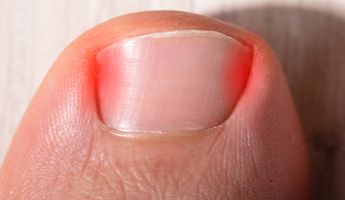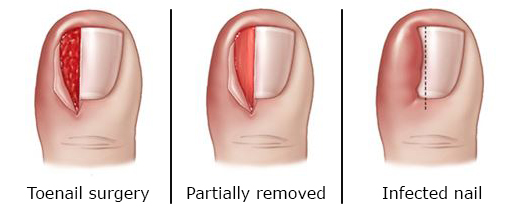Ingrown Toenail Treatment in Costa Rica
Search and Compare the Best Clinics and Doctors at the Lowest Prices for Ingrown Toenail Treatment in Costa Rica

Find the best clinics for Ingrown Toenail Treatment in Costa Rica
No pricing info available
Malaysia offers the best prices Worldwide
Price: $ 13
Clinica Hospital Santa Catalina, located in Radial Francisco J Orlich, Alajuela, Costa Rica offers patients Ingrown Toenail Treatment procedures among its total of 171 available procedures, across 4 different specialties. Currently, there's no pricing information for Ingrown Toenail Treatment procedures at Clinica Hospital Santa Catalina, as all prices are available on request only. All procedures and treatments are undertaken by the lead specialist at the Hospital, and they are accredited by Costa Rica Ministry of Health
- Home
- Costa Rica
WHY US?
At Medijump, we're making medical easy. You can search, compare, discuss, and book your medical all in one place. We open the door to the best medical providers worldwide, saving you time and energy along the way, and it's all for FREE, no hidden fees, and no price markups guaranteed. So what are you waiting for?

Free

Best Price

Widest Selection

Risk-Free
What you need to know about Ingrown Toenail Treatment in Costa Rica

An ingrown toenail, also known as onychocryptosis, is a condition that occurs when the edge of the nail grows into the skin of the toe. It can result in swelling, pain, and redness. Sometimes, you can take care of ingrown toenails on your own. However, if the pain is spreading or severe, you may need medical treatments. You may also want to promptly seek medical treatments if you have diabetes, a compromised immune system, or poor circulation.
The treatment option for ingrown toenail may include lifting the nail, removing some of the nail (partial nail removal), and removing all of the nail and tissue (total nail removal). The type of treatment you will undergo depends on your specific condition.
What does the Procedure Involve?
Lifting the nail
If your problem is mild, meaning the nail is only slightly ingrown and there is no pus, your doctor may be able to carefully lift the edge of the ingrown nail and place a splint, dental floss, or cotton under it. The splint, dental floss, or cotton will set the nail in a new position, separating the nail from the overlying skin and helping it to grow above the skin.
Partial nail removal
Partial nail removal may be needed for a more severe ingrown toenail. This means that there’s redness, pain, and pus.
During partial nail removal, your doctor will cut away the sides of the nail so that the edges are completely straight. Then, a piece of cotton or a splint is placed under the remaining portion of the nail in order to stop the ingrown toenail from recurring. In some cases, your doctor may also use a compound called phenol to treat your toe. Phenol can keep the nail from growing back.
Total nail removal
If you experience ingrown toenails repeatedly on the same toe or if your ingrown toenail is caused by thickening, your doctor may remove your whole nail along with the underlying tissue (nail bed).
To start the procedure, your doctor will loosen the skin around and from the nail. Then, the nail is separated from the skin by using a special tool under the nail. Your doctor may use a laser, a chemical, or other methods to remove the nail.
All procedures are performed under local anesthesia, which is injected directly into the toe. With local anesthesia, you will be awake but your toe will be numbed, so you will not feel anything throughout the procedure.
How Long Should I Stay in Costa Rica?
You are allowed to leave the hospital on the same day of your ingrown toenail treatment. However, it is recommended that you stay in Costa Rica for a few days following the surgery, at least 3 days, to let your toenail to recover before you travel home. It may be uncomfortable for you to travel long distances during your initial recovery time.
What's the Recovery Time?
Recovery can be different for everyone. On average, it takes about four to six weeks to heal after partial nail removal and around 10 to 12 weeks after total nail removal. During the recovery time, you should be able to walk and carry on your life as normal after 3 days of rest. However, you need to avoid strenuous activities, including running and jumping for 2 weeks. It is also advisable that you avoid taking part in sports activities and dancing until you have fully healed.
What About Aftercare?
Your doctor will give you specific aftercare instructions, which may include:
-
If your doctor gives you pain reliever make sure to take it as directed. Your doctor may also give you oral or topical Medication (antibiotics) which helps get rid of the infection.
-
Keep your foot raised for a day or two to allow your toe to heal properly.
-
Wear special footwear for the first few days. Then, you can slowly start wearing sandals or open-toed shoes until the area feels better.
-
Avoid picking at the wound.
-
Keep the wound clean and dry, except when cleaning the area or showering.
-
Soak your toenails with salt water daily.
What's the Success Rate?
Ingrown toenail treatment is a safe procedure. According to the National Health Services (NHS), partial nail removal is 98% effective in preventing future ingrown toenails. It is important, however, to remember that every type of surgery carries some possible risks, such as toenail deformity, infection, and anesthesia complications. Serious complications are typically rare and untreated ingrown toenails carry a much higher risk of complications.
Are there Alternatives to Ingrown Toenail Treatment?
If your ingrown toenail is not infected, you should be able to treat it with home remedies, such as keeping your feet dry, soaking your feet in warm water, using a wedge to lift your nail and apply antibiotic creams. However, if your ingrown toenail is infected, there’s no alternative than to get the medical treatments mentioned above.
What Should You Expect Before and After the Procedure
Before ingrown toenail treatment, you may experience swelling, tenderness, hardness, redness, bleeding, pain, and pus coming out of your toe. In some cases, the condition can be serious and cause an infection in the bone, leading to foot ulcers and tissue decay at the site. After treatment, all of the painful symptoms you experience before will be relieved and the chance of the condition to complicate will be reduced.
Whilst the information presented here has been accurately sourced and verified by a medical professional for its accuracy, it is still advised to consult with your doctor before pursuing a medical treatment at one of the listed medical providers
No Time?
Tell us what you're looking for and we'll reachout to the top clinics all at once
Enquire Now

Popular Procedures in Costa Rica
Prices Start From $14

Prices Start From $4

Prices Start From $106

Prices Start From $11

Recommended Medical Centers in Costa Rica for Ingrown Toenail Treatment

- Interpreter services
- Translation service
- Religious facilities
- Medical records transfer
- Medical travel insurance
- Health insurance coordination
- TV in the room
- Safe in the room
- Phone in the room
- Private rooms for patients available

- Interpreter services
- Translation service
- Religious facilities
- Medical records transfer
- Medical travel insurance
- Health insurance coordination
- TV in the room
- Safe in the room
- Phone in the room
- Private rooms for patients available

- Interpreter services
- Translation service
- Religious facilities
- Medical records transfer
- Medical travel insurance
- Health insurance coordination
- TV in the room
- Safe in the room
- Phone in the room
- Private rooms for patients available

- Interpreter services
- Translation service
- Religious facilities
- Medical records transfer
- Medical travel insurance
- Health insurance coordination
- TV in the room
- Safe in the room
- Phone in the room
- Private rooms for patients available
Ingrown Toenail Treatment in and around Costa Rica
Costa Rica is a tiny country in Central America, bordered by Panama, Nicaragua, the Caribbean Sea, and the Pacific Ocean. This country is generally regarded as having the most democratic and stable government of all the Central American countries. It charms its visitors with unspoiled beaches, lush rainforests, a plethora of wildlife, and steaming volcanoes. Besides its breathtaking landscape, Costa Rica is also famous for its healthcare. Tens of thousands of medical tourists come to this country to take advantage of its world-class yet inexpensive medical care. Most of the medical procedures in the country are 40% to 50% cheaper than in the United States or Europe. Cosmetic surgery and dentistry are the most sought-after procedure, but a growing number of foreign patients also come for orthopedic treatment, bariatric surgery, and eye surgery.
Popular Parts of Costa Rica
Surrounded by volcanoes and green hills, San José, the capital and largest city of Costa Rica, has one of the most spectacular settings in the world. This laid-back and pleasant capital is filled with colonial mansions that have been converted into contemporary galleries, amazing food, and vibrant nightlife. The most popular attractions in this city are Museo de Jade, Teatro Nacional, Museo Nacional de Costa Rica, and Mercado Central. Those who want to relax under the sun usually visit Tamarindo, which is famous for its beaches. Here, visitors can visit Las Baulas National Marine Park, go rafting in the Colorado River, or relax in Playa Tamarindo.
Weather and Climate in Costa Rica
Due to its close proximity to the Equator, Costa Rica is a tropical country with two seasons: the dry “summer” season and rainy “winter” season. The dry season, from January to April, is warm and pleasant. Rain is very unlikely to fall during this season, even in the rainforests. The rainy season, sometimes called the “green season,” is hot and humid. Rain usually falls in the afternoon and evening, while the mornings are often sunny. On the Caribbean coast, rainfall is spread out throughout the year, but it gets far less rain in September and October.
Getting around in Costa Rica
Juan Santamaría International Airport is the main international airport in Costa Rica, located in San José. It has various flights to domestic and international destinations, including Toronto, Mexico, New York, and London. Affordable domestic flights between San José and popular destinations are the fastest way to get around and handy for accessing the more remote areas. Buses are reasonably priced and have an extensive network, but they can be slow. Private and shared shuttles are available, the best way to get around is, however, by renting a car as it gives more flexibility and allows you to access more remote destinations.
Tourist Visas in Costa Rica
Everyone who wants to visit and stay in Costa Rica is required to have a passport unless they are a citizen of one of the visa-exempt countries. The visa-exempt countries include EU countries, the UK, the US, Australia, Russia, and several other nations. Citizens of other countries not listed in the visa exemption agreement need to apply and obtain a visa before visiting.
Additional Information
- Local Currency: Colón (CRC) is the national currency of Costa Rica. 1 USD is equivalent to 601 CRC. In some places, such as tourist areas, US dollars are accepted.
- Money & Payments: ATMs accepting foreign cards, particularly Visa, can be found in all major cities and small towns. Credit cards, such as Visa and MasterCard, are all accepted in larger establishments. Tipping is not mandatory but appreciated.
- Local Language: Costa Rican Spanish is the official and most commonly spoken language in Costa Rica. English is widely spoken in tourist areas.
- Local Culture and Religion: Roman Catholicism is the official religion in Costa Rica, but the constitution provides for freedom of religion. Around 17% of the population is unaffiliated with any religions and around 3% follows either Buddhism, Islam, Judaism, Hinduism, Neo-Paganism, or other religions.
- Public holidays: New Year’s Day, Juan Santamaria Day, Guanacaste Day, Assumption, Mother’s Day, Independence Day, Day of the Cultures, and Christmas Day are some of the most celebrated public holidays in Costa Rica.
Popular Searches
- Plastic Surgery in Thailand
- Dental Implants in Thailand
- Hair Transplant in Thailand
- Breast Augmentation Thailand
- Gastric Sleeve in Thailand
- Gender Reassignment Surgery in Thailand
- Laser Hair Removal in Bangkok
- Botox in Bangkok
- Dermatology in Bangkok
- Breast Augmentation in Bangkok
- Coolsculpting in Bangkok
- Veneers in Turkey
- Hair Transplant in Turkey
- Rhinoplasty in Turkey
- Stem Cell Therapy in Mexico
- Rhinoplasty in Mexico
- Liposuction in Mexico
- Coolsculpting in Tijuana
- Rhinoplasty in Korea
- Scar Removal in Korea
- Gastric Sleeve in Turkey
- Bone Marrow Transplant in India
- Invisalign in Malaysia
- Plastic Surgery in the Dominican Republic
- Tummy Tuck in the Dominican Republic
- Plastic and Cosmetic Surgery in Poland
- Rhinoplasty in Poland
- Hair Implant in Poland
- Dental Implants in Poland
- IVF in Turkey